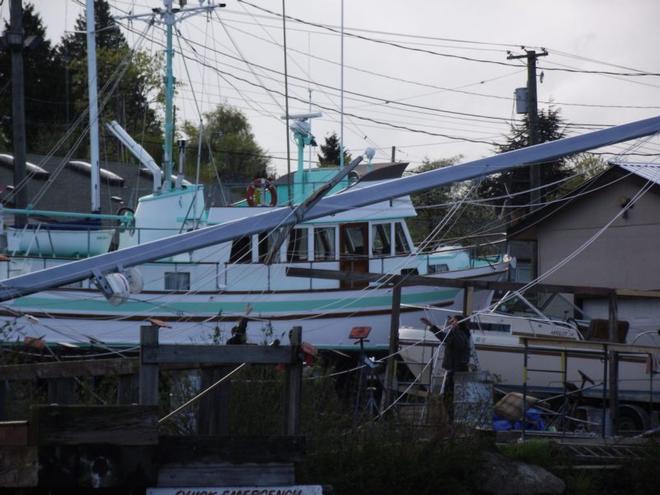Why is that furling line so tight?
by Harry Nichols on 6 Apr 2017

Port Graves on the south-west side of Gambier Island Harry Nichols
The adventure begins in Port Graves on the south-west side of Gambier Island in the Salish Sea. It is December 31st and I am to meet a group of friends on the backside of Gambier… in a little hole, for New Year’s Eve celebrations. It’s a lazy morning, lots of coffee, eating, laying about and enjoying the morning.
I called my buddy, Russ, from Vancouver, about 1130h. He is halfway, so I pull up anchor and sail away without starting the engine. I’m feeling pretty proud of myself. In 10-13 knots of wind from the north-east, and 4 gybes later, I am out of Port Graves. Russ has gone by with only a foresail up. I turned and followed, trying to catch him. I figured “it shouldn’t be too difficult…I have two sails and he’s only got one”.
Before I could catch him though, the wind died and he furled the sail and started to motor. The race is over. I’m just coming beam on to Grace Island, and decide to furl the Genoa, but it seems to be “stuck”. This has happened before and I have not yet figured out why. So I go forward to check the drum. It appears the line has an over ride. What I didn’t notice was that the spinnaker halyard aloft had become twisted with the sail.
So I headed back to the cockpit and put the furling line on a winch, thinking that I would just pull out the override. This has helped with the override in the past, so I was confident it would pull right out. As I was getting a good pull on the winch, suddenly I “felt” a thud and a shudder through the whole boat.
Panic strikes and I think “oh no…this can’t be good”, as I’m racing forward to see what has happened. The furler appears to be very “saggy”, so I look up and to my horror, see that the furler has completely parted from the masthead. As I look at the now spaghetti-like mast, I realize that I am about to lose my rig, as the main is still up.
I race back to the cockpit, release the main sheet and frantically furl the main (in-mast furling). It only takes less than half a minute, but it seems like forever as I keep looking up, waiting for the mast to come crashing down. My adrenaline has certainly kicked in.
Without thinking it all the way through, I came to the conclusion that I need to stabilize the mast, but I need the halyard for this. So I began to untangle the halyard from the sail by manually turning it with my hands. But this made a bad situation worse, as the furler came free and went crashing into the water, along with about half of the unfurled Genoa. With another spike of adrenaline, I realized that I had to get the sail and furler back onboard before it filled with water.
My heart felt like it wanted to jump out of my chest. I scrambled to gather the sail and the furler and drag them onboard, inside the lifelines. It was getting heavier and heavier as it filled with water, though fortunately, the sail was partially furled. Finally, the entire sail was on deck, but half the furler was still in the water.
I was losing my strength, but summoned just enough to haul the last part of the furler up over the aft pushpit, onto the rail. There was still about ten feet sticking out the back and the tip of the furler was just bobbing in and out of the water.
I collapsed on the deck, trying to catch my breath. The last few minutes seemed surreal. How can this be, I’m thinking. “You’ve really done it this time”. After catching my breath, I went forward to put the halyard on the bow point and winch it up to stabilize the mast. At least I still had the mast standing.
The lessons learned were as follows, in no particular order:
Never put the furling line on a winch. If it doesn’t furl, something is not right;
Always look up when something doesn’t seem right;
Never stow the spinnaker halyard on the bowsprit;
Think your actions through before knee jerk reactions. The mast is stronger than it appears, and the intermediate shrouds and running stays will support it, un-powered;
Always do a rig inspection as part of the purchase conditions. When I bought the boat, I had passed on the rig inspection due to lack of funds. That was a mistake, as it would possibly have revealed prior damage. Upon inspection of the broken stay, we found that the previous owner had also had an issue similar to mine. The extrusion for the furler was previously damaged and the stay was partially cut in a prior incident. This was revealed by corrosion on broken strands of wire and the twisted extrusion.
This article has been provided courtesy of the Bluewater Cruising Association.
If you want to link to this article then please use this URL: www.sailworldcruising.com/152877